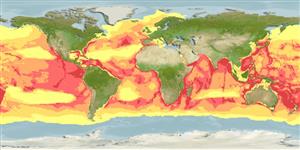Mammalia |
Cetartiodactyla |
Kogiidae
Environment: milieu / climate zone / depth range / distribution range
Ecology
Pelagic; non-migratory (Ref. 75906); depth range 0 - 1989 m (Ref. 116169). Tropical; 90°N - 90°S, 180°W - 180°E
Indo-Pacific, Atlantic Ocean and the Mediterranean. Tropical to warm temperate zones.
Length at first maturity / Size / Weight / Age
Maturity: Lm ?, range 210 - 220 cm Max length : 270 cm TL male/unsexed; (Ref. 1394); max. published weight: 210.0 kg (Ref. 1394)
Usually in deeper offshore waters. Typically in groups of less than 5 individuals (Ref. 801). Feeds on deep water cephalopods (Refs. 801, 1394) and crustaceans (Ref. 122680).
Life cycle and mating behavior
Maturity | Reproduction | Spawning | Eggs | Fecundity | Larvae
Females may become pregnant in successive breeding seasons. Mating occurs in summer. Calving lasts over 5 months (Ref. 97768).
Jefferson, T.A., S. Leatherwood and M.A. Webber 1993 FAO species Identification Guide: Marine Mammals of the World. Rome, FAO. 320 p. + 587 figures. (Ref. 1394)
IUCN Red List Status
(Ref. 130435: Version 2025-1)
CITES status (Ref. 108899)
Not Evaluated
Threat to humans
Human uses
Fisheries: commercial
FAO - Fisheries: landings, species profile | FishSource | Sea Around Us
Tools
More information
Population dynamicsGrowthMax. ages / sizesLength-weight rel.Length-length rel.Length-frequenciesMass conversionAbundance PhysiologyOxygen consumption
Human RelatedStamps, coins, misc.
Internet sources
Estimates based on models
Preferred temperature
(Ref.
115969): 2.4 - 13.9, mean 4.5 (based on 4397 cells).
Fishing Vulnerability
Very high vulnerability (81 of 100).
Price category
Unknown.
